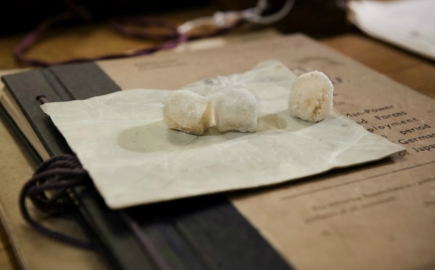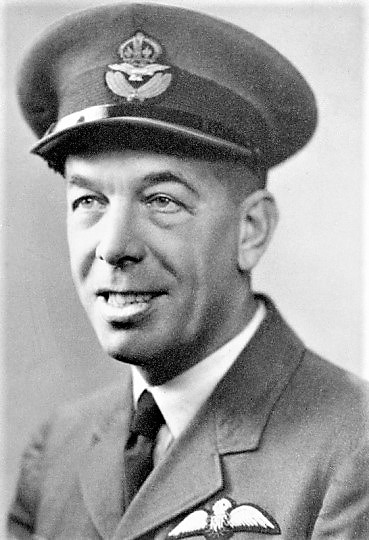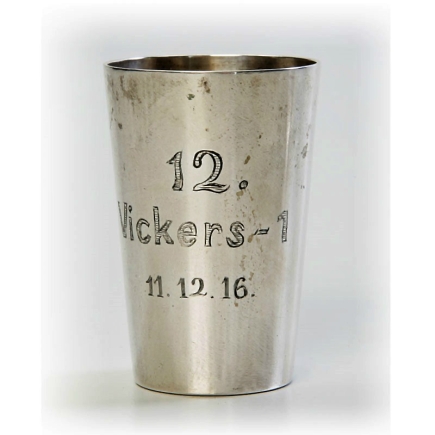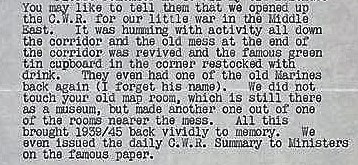BY RICHARD MADDOX

Sugar cubes belonging to Wing Commander John Heagerty RAF. © IWM SITE CWR 389
THE MAP ROOM AT CABINET WAR ROOMS was once a secret place at the heart of a very secret place.
Here the war was charted, briefings were prepared for Prime Minister Winston Churchill, and secret papers littered desks. Telephones were connected by operators instantly to both neighbouring offices and far flung units at home and abroad at any time of day or night.
And long after the war ended it still kept a secret about a key man working there.

Wing Commander John Heagerty, around 1940. © IWM HU 46096
Wing Commander John Seymour Heagerty RAF manned the Map Room Air Desk for more than five years co-ordinating information about air operations.
And he kept part of his sugar ration – a scarce commodity both during the war and after until 1953 – in an envelope marked with his name and pushed to the back of a desk drawer.
For almost four decades after the War Rooms were vacated in 1945 the sugar remained as it was left, found only when the site was surveyed by IWM staff before opening to the public in 1984.
It has been suggested that the sugar’s shape is because Heagerty shaved or broke off pieces for his beverages. (1) (2) However, it is also possible that he had access to slab sugar – some of which was made to be sent to British prisoners of war – and simply cut his own (irregular) cubes.
At the moment we don’t know for certain.
What we do know is that these humble blocks of sugar show a very human side of the war. And perhaps a very British belief that a cup of tea will make things better – even just for a few moments.
And the Red Baron?
During the First World War Lieutenant Heagerty was a pilot with No. 43 Squadron, Royal Flying Corps (RFC).
Joining the British Army on 29 August 1914 – little more than three weeks after war was declared – he served in 25th (County of London) Cyclist (Home Service) Battalion, London Regiment, as a cyclist and transport driver.
On 11 May 1915 he was commissioned as a 2nd Lieutenant into 9th Battalion, East Kent Regiment and in March 1917 he was attached to 2/4 Royal West Kent Regiment, joining that regiment at Fayoum (Al Fayyum) in Egypt on 16 March 1917.
Six months later on 3 September 1916 he boarded a ship from Alexandria back to England. He was to going to join the RFC (3) and after training he was sent to France. (4)
According to a post-war report, on Easter Sunday, 8 April 1917 the newly appointed Flight Lieutenant Heagerty RFC and his observer, Lieutenant Leonard Heath Cantle, RFC were patrolling near Vimy when their aircraft – a two – seater Sopwith 11/2 Strutter biplane, serial A2046 (5) – was attacked by two enemy aircraft.
In the ensuing battle Cantle was wounded. Heagerty broke away but with the aircraft’s controls shot away ‘came down out of control’. (6)
Although unscathed in the attack, Heagerty was injured when the aircraft crash at Farbus, about 1.5 miles (2.5 km) from Vimy. (7)
Cantle died as a result of the crash and his battle wounds. He is commemorated on the Arras Flying Services Memorial. (8) (9)
Heagerty was captured and while recovering after the crash was visited by the pilot who claimed the victory Manfred von Richtofen – the famous ‘Red Baron’). (10)
He was to spend the rest of the war a prisoner, being repatriated at its end and arriving back in Britain on 19 December 1918. (11)
In August 1919 an Army Council Committee of Enquiry found that ‘no blame attaches to him [Heagerty] in the matter’ of the loss of the aircraft and the death of Lieutenant Cantle. (12)
Just over a year after his downing of Heagerty and Cantle, the 25 year-old Manfred von Richtofen scored his 80th and last victory on 20 April 1918. He was killed the next day.
Heagerty and Cantle’s aircraft had been his 38th victory and the first of two that day. (13)
For each of the first 60 of his victories, Richtofen commissioned a silversmith to make a small silver ‘victory’ cup from which he could toast his foe. Each one was sequentially numbered, dated and engraved with details of the enemy aircraft he had downed.
There is some confusion regarding The Red Baron’s victory cups
ate that pewter examples were made. (15)
Today very few are known to exist.
According to the description accompanying unedited footage made in or around 1977 by Anglia Television (a British television production company) now in the IWM collection, Heagerty attempted to acquire the victory cup relating to the shooting down of his aircraft from von Richtofen widow. (16)

This cup commemorates the Red Baron’s 12th victory, the downing of Lieutenant Benedict Philip Hunt on 11 December 1917. The one marking The Red Baron’s victory over Heagerty and Cantle would have been generally similar. Image http://www.warmuseum.ca/deadlyskies/
CWR and ‘… our little war in the Middle East’
August 15, 1945 is generally accepted as the last day the Cabinet War Rooms were in operation. However, a letter from Air Marshall William F Dickson RAF to Heagerty and held in the IWM Collection may indicate differently.
According to his private papers now in the IWM Collection, Heagerty left the Cabinet War Rooms (as CWR was known during the war) around the end of July 1945. He was to remain connected with the site for many years, organising dinners and reunions into the 1960s.
On 22 November 1956 Dickson wrote to Heagerty declining an invitation to a CWR dinner as he was ‘dining with the Queen and the Army Council!’
He would go on to say in the same letter…(17)

Extract from letter dated 22 November 1965 to Wing Commander Heagerty from Air Marshall Dickson mentioning CWR and ‘our little war in the Middle East’. Image from IWM Collection http://www.iwm.org.uk/collections/item/object/1030002942 Image 7: Letter from Marshall of the Royal Air Force William F Dickson, GCB, KBE, DSO, AFC dated 22 November 1956.
A coalition of Britain, France and Israel were involved in the ‘Suez Crisis’ – a military operation to take possession of the Suez Canal which Egyptian President Gamal Abdul Nasser had nationalised, it had been run by the Suez Canal Company. The French and British together launched ‘Operation MUSKETEER’, while the Israeli operation was known as ‘KADESH’ on 29 October 1956.
Hostile pressure from the United Nations, Soviet Union and United States caused the military action to be halted and a ceasefire was put in place on 7 November 1956.
NOTE:
* At least one source uses Heath-Cantle for the name of the observer (5), however Heagerty uses ‘Cantle’ in his report of the incident (7), as does Charter House school (8) and the Commonwealth War Graves Commission. (9)
SOURCES
(1) http://www.iwm.org.uk/history/how-sugar-cubes-reveal-churchill-war-rooms-well-preserved-past
– retrieved 19August 2017.
(2) http://www.iwm.org.uk/history/nine-secrets-from-churchill-war-rooms – retrieved 19August 2017.
(3) Air 76/219/42 – UK National Archives.
(4) Air 76/219/42 – UK National Archives.
(5) http://www.theaerodrome.com/aircraft/serial_numbers.php?pageNum_serials=883&totalRows_serials=16893&q=&sortby=2 – retrieved 19August 2017.
(6) Air 76/219/42 – UK National Archives.
(7) https://aviation-safety.net/wikibase/wiki.php?id=79813 – retrieved 19August 2017.
(8) http://charterhousewarmemorial.org.uk/RollofHonour.aspx?RecID=109&TableName=ta_factfile – retrieved 19 August 2017.
(9) http://www.cwgc.org/find-war-dead/casualty/743623/CANTLE,%20LEONARD%20HEATH – retrieved 19 August 2017.
(10) http://www.iwm.org.uk/collections/item/object/1060000127 Description after Slate 52/ Take 1: more about his combat career. Squadron leader was Sholto Douglas. Nearly all flying done over enemy lines. Easter Sunday 1917, shot down behind those lines. Pilot comes to visit him in his sickroom (von Richthofen). Moved to hospital – retrieved 20 August 2017.
(11) Air 76/219/42 – UK National Archives.
(12) Air 76/219/42 (enclosure 2A) – UK National Archives.
(13) https://en.wikipedia.org/wiki/List_of_victories_of_Manfred_von_Richthofen – retrieved 19 August 2017.
(14) https://www.thedrinksbusiness.com/2016/08/schnapps-to-mark-100th-anniversary-of-red-barons-first-victims/ – retrieved 19 August 2017.
(15) http://www.warmuseum.ca/deadlyskies/ – retrieved 20 August 2017.
(16) http://www.iwm.org.uk/collections/item/object/1060000127 Description after Slate 54/ Take 1: von Richthofen’s sickroom visit. After the war, Mr Heagerty tries to get a small commemorative trophy (bearing his name) from von Richthofen’s widow – retrieved 20 August 2017.
(17) http://www.iwm.org.uk/collections/item/object/1030002942
Image 7: Letter from Marshall of the Royal Air Force William F Dickson, GCB, KBE, DSO, AFC dated 22 November 1956. – retrieved 21 August 2017.